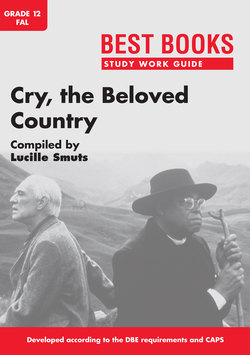Читать книгу Best Books Study Work Guide: Cry, the Beloved Country - Lucille Smuts - Страница 16
На сайте Литреса книга снята с продажи.
3.4 Setting
ОглавлениеThe setting of a novel describes the place, time, social environment, mood and atmosphere of the action in a story.
Time: Cry, the Beloved Country is a historical novel. It was written in 1946. The only indication of time in the novel is the first letter from Msimangu to Reverend Kumalo dated 25 September 1946 (p. 5 in your school edition). We know that Absalom will be hanged on the 15th of the month, although we don’t know which month.
The principles of contrast and repetition operate in the description of social environment, place, mood and atmosphere in Cry, the Beloved Country.
Social environment: The story includes references to historical events that took place in the 1940s: the bus boycott from Alexandra to Johannesburg in 1943; the development of Shanty Town; the discovery of gold at Odendaalsrust in April 1946 and the miners’ strike on 12 August 1946. The novel describes the social inequalities that existed between Europeans and non-Europeans in the 1940s as a result of the government’s segregation and migrant labour laws. It is a novel of social protest.
The descriptions of the social environment in Ndotsheni and in Johannesburg therefore repeat the emphasis on the poverty and suffering of black people. However, the love and care of the community in Ndotsheni contrasts with the fear and distrust of people living in Johannesburg. Black and white are corrupted by greed for more money and power.
Place: The simplicity of the hilly landscape of rural Natal, the farm High Place and the valley of Ndotsheni contrasts with the complex layout of gold mines and skyscrapers of the city, Johannesburg, and its surrounding townships.
Msimangu, who guides Reverend Kumalo in the city, explains the layout of the townships at the beginning of Chapter Six in Book One (p. 23 in your school edition). “It is not far to Claremont. They lie together: Sophiatown, where any man may own property, Western Native Township which belongs to the Municipality of Johannesburg, and Claremont, the garbage-heap of the proud city.”
Mood and atmosphere: The description of the mood and atmosphere in which the action of the novel takes place varies according to the specific context of the setting. For example, in Book One, Chapter Four, the description of Reverend Kumalo’s first glimpse of Johannesburg from the train creates a restless atmosphere. He is overwhelmed and confused by the high buildings and the never-ending changing of colours. “He sees great high buildings; there are red and green lights on them, almost as tall as the buildings. They go on and off. Water comes out of a bottle, till the glass is full. Then the lights go out. And when they come on again, lo the bottle is full and upright, and the glass is empty. And there goes the bottle over again. Black and white, it says, black and white, though it is red and green. It is too much to understand.” (pp. 13–14 in your school edition).
This description of the restless atmosphere in Johannesburg contrasts with descriptions of the tranquillity of a rural landscape in the first chapters of Books One and Two and in the last chapter of Book Three.
